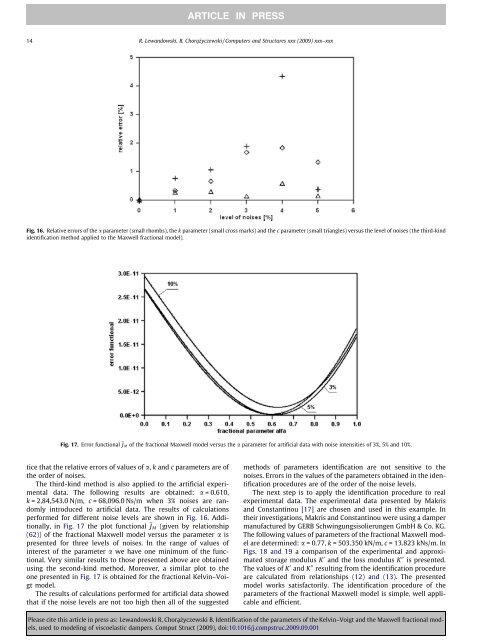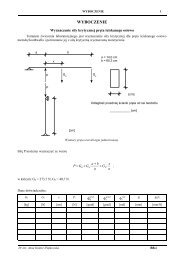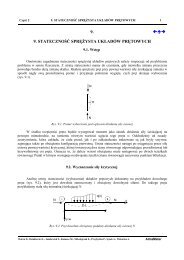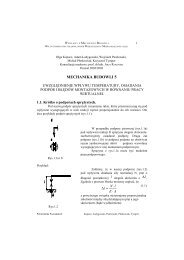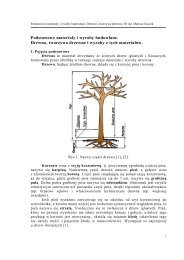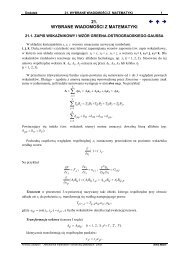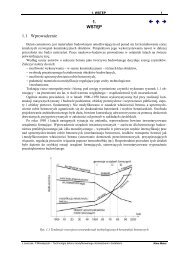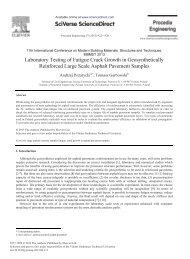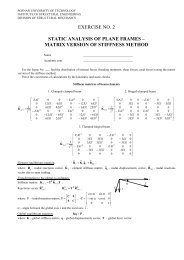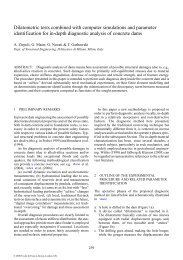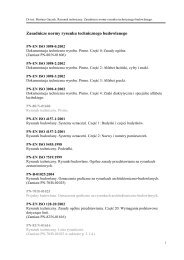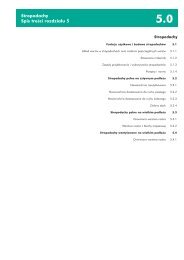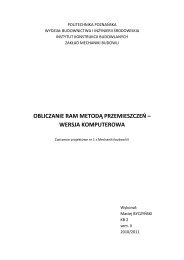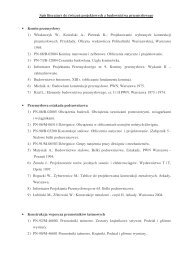Identification of the parameters of the Kelvin–Voigt and the Maxwell ...
Identification of the parameters of the Kelvin–Voigt and the Maxwell ...
Identification of the parameters of the Kelvin–Voigt and the Maxwell ...
You also want an ePaper? Increase the reach of your titles
YUMPU automatically turns print PDFs into web optimized ePapers that Google loves.
ARTICLE IN PRESS<br />
14 R. Lew<strong>and</strong>owski, B. Chorą_zyczewski / Computers <strong>and</strong> Structures xxx (2009) xxx–xxx<br />
Fig. 16. Relative errors <strong>of</strong> <strong>the</strong> a parameter (small rhombs), <strong>the</strong> k parameter (small cross marks) <strong>and</strong> <strong>the</strong> c parameter (small triangles) versus <strong>the</strong> level <strong>of</strong> noises (<strong>the</strong> third-kind<br />
identification method applied to <strong>the</strong> <strong>Maxwell</strong> fractional model).<br />
Fig. 17. Error functional e J M <strong>of</strong> <strong>the</strong> fractional <strong>Maxwell</strong> model versus <strong>the</strong> a parameter for artificial data with noise intensities <strong>of</strong> 3%, 5% <strong>and</strong> 10%.<br />
tice that <strong>the</strong> relative errors <strong>of</strong> values <strong>of</strong> a, k <strong>and</strong> c <strong>parameters</strong> are <strong>of</strong><br />
<strong>the</strong> order <strong>of</strong> noises.<br />
The third-kind method is also applied to <strong>the</strong> artificial experimental<br />
data. The following results are obtained: a = 0.610,<br />
k = 2,84,543.0 N/m, c = 68,096.0 Ns/m when 3% noises are r<strong>and</strong>omly<br />
introduced to artificial data. The results <strong>of</strong> calculations<br />
performed for different noise levels are shown in Fig. 16. Additionally,<br />
in Fig. 17 <strong>the</strong> plot functional e J M (given by relationship<br />
(62)) <strong>of</strong> <strong>the</strong> fractional <strong>Maxwell</strong> model versus <strong>the</strong> parameter a is<br />
presented for three levels <strong>of</strong> noises. In <strong>the</strong> range <strong>of</strong> values <strong>of</strong><br />
interest <strong>of</strong> <strong>the</strong> parameter a we have one minimum <strong>of</strong> <strong>the</strong> functional.<br />
Very similar results to those presented above are obtained<br />
using <strong>the</strong> second-kind method. Moreover, a similar plot to <strong>the</strong><br />
one presented in Fig. 17 is obtained for <strong>the</strong> fractional Kelvin–Voigt<br />
model.<br />
The results <strong>of</strong> calculations performed for artificial data showed<br />
that if <strong>the</strong> noise levels are not too high <strong>the</strong>n all <strong>of</strong> <strong>the</strong> suggested<br />
methods <strong>of</strong> <strong>parameters</strong> identification are not sensitive to <strong>the</strong><br />
noises. Errors in <strong>the</strong> values <strong>of</strong> <strong>the</strong> <strong>parameters</strong> obtained in <strong>the</strong> identification<br />
procedures are <strong>of</strong> <strong>the</strong> order <strong>of</strong> <strong>the</strong> noise levels.<br />
The next step is to apply <strong>the</strong> identification procedure to real<br />
experimental data. The experimental data presented by Makris<br />
<strong>and</strong> Constantinou [17] are chosen <strong>and</strong> used in this example. In<br />
<strong>the</strong>ir investigations, Makris <strong>and</strong> Constantinou were using a damper<br />
manufactured by GERB Schwingungsisolierungen GmbH & Co. KG.<br />
The following values <strong>of</strong> <strong>parameters</strong> <strong>of</strong> <strong>the</strong> fractional <strong>Maxwell</strong> model<br />
are determined: a = 0.77, k = 503.350 kN/m, c = 13.823 kNs/m. In<br />
Figs. 18 <strong>and</strong> 19 a comparison <strong>of</strong> <strong>the</strong> experimental <strong>and</strong> approximated<br />
storage modulus K 0 <strong>and</strong> <strong>the</strong> loss modulus K 00 is presented.<br />
The values <strong>of</strong> K 0 <strong>and</strong> K 00 resulting from <strong>the</strong> identification procedure<br />
are calculated from relationships (12) <strong>and</strong> (13). The presented<br />
model works satisfactorily. The identification procedure <strong>of</strong> <strong>the</strong><br />
<strong>parameters</strong> <strong>of</strong> <strong>the</strong> fractional <strong>Maxwell</strong> model is simple, well applicable<br />
<strong>and</strong> efficient.<br />
Please cite this article in press as: Lew<strong>and</strong>owski R, Chorą _zyczewski B. <strong>Identification</strong> <strong>of</strong> <strong>the</strong> <strong>parameters</strong> <strong>of</strong> <strong>the</strong> Kelvin–Voigt <strong>and</strong> <strong>the</strong> <strong>Maxwell</strong> fractional models,<br />
used to modeling <strong>of</strong> viscoelastic dampers. Comput Struct (2009), doi:10.1016/j.compstruc.2009.09.001


